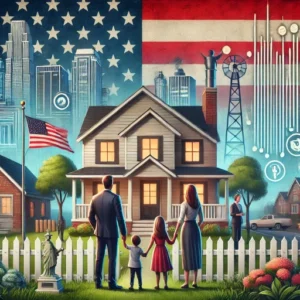The American Dream is alive and well, and it’s this spirit that keeps the U.S. ruling the world in countless ways—through innovation, culture, and a deep commitment to individual liberty and global progress.
Throughout history, the United States of America has established itself as a global leader, influencing countless aspects of culture, politics, economics, and technology. But what makes Americans stand out on the world stage? What is the key to their global dominance and success? In this blog, we will explore the unique traits that define Americans, the values that drive their excellence, and the factors that make them a world powerhouse.
-
A Culture of Innovation and Entrepreneurship
One of the most defining characteristics of the American spirit is its innovation. From the invention of the lightbulb by Thomas Edison to the founding of tech giants like Apple, Google, and Microsoft, Americans have a history of being at the forefront of scientific and technological advancements. This innovation is supported by a culture that values entrepreneurship and risk-taking. The American Dream encourages people to pursue their passions, take risks, and turn their ideas into reality, fostering a dynamic and creative society.
-
Diverse and Inclusive Society

America’s strength lies in its diversity. As a nation built by immigrants from all corners of the globe, the U.S. has become a melting pitcher of values, cultures, languages, and traditions. This diversity brings different perspectives and ideas, which fuels creativity and problem-solving. Moreover, the emphasis on equality and civil rights has allowed individuals of all backgrounds to rise and contribute to the nation’s success. From African Americans breaking barriers in civil rights to immigrants becoming successful entrepreneurs, the diverse fabric of American society is a major factor in its global influence.
-
World-Class Education System
The United States is home to some of the most prestigious universities and research institutions in the world, including Harvard, MIT, and Stanford. The American education system promotes critical thinking, creativity, and innovation. It is a hub for international students seeking higher education, which further enriches the intellectual landscape. The focus on research and development in these institutions has led to groundbreaking discoveries and advancements in various fields, from medicine to space exploration.
-
Strong Military and Economic Power
Another reason Americans are considered leaders on the global stage is their unmatched military and economic power. The U.S. has the largest economy in the world, with major influence over global markets, trade, and finance. American companies dominate industries like tech, entertainment, and pharmaceuticals. Additionally, the United States has the most advanced military in the world, with a global presence that allows it to protect its interests and promote peace and democracy across the globe.
-
Emphasis on Freedom and Democracy
One of the cornerstones of American society is its commitment to freedom and democracy. The U.S. Constitution and Bill of Rights guarantee fundamental liberties that protect the rights of its citizens. These values are not only central to American identity but have also shaped the way the country interacts with the rest of the world. The promotion of democracy and human rights has been a major aspect of U.S. foreign policy, influencing nations across the globe.
-
Resilience and Adaptability
Americans are known for their resilience and ability to adapt to challenges. Whether it’s recovering from economic downturns, natural disasters, or global crises, the people of the U.S. have consistently demonstrated an unshakable determination to rebuild and innovate. This resilience is deeply ingrained in the national ethos and is a key reason why America remains a global leader.
From Hollywood movies to American music and fashion, the U.S. has a profound influence on global culture. American media and entertainment are consumed around the world, shaping trends, opinions, and tastes. The country’s soft power, through cultural exports, has allowed it to maintain a significant presence in global discourse, shaping how the world views itself and others.
-
Focus on Individual Achievement and Competition

Americans are highly competitive, both as individuals and as a nation. This competitive spirit is ingrained in the education system, sports, and professional life. It drives people to strive for success, push boundaries, and continually improve. This culture of competition has led to extraordinary achievements in various fields, from space exploration to sports championships, further cementing America’s status as a global leader.
-
Leadership in Technology and Space Exploration
The United States is a pioneer in space exploration, with NASA leading the charge since the Apollo moon landings in 1969. America’s leadership in technology is also evident in Silicon Valley, where some of the most influential tech companies and innovators have emerged. The country’s commitment to pushing the boundaries of what’s possible has ensured its dominance in the tech and space sectors, contributing to its global leadership.
-
Philanthropy and Global Aid
Americans are known for their generosity and humanitarian efforts. The United States consistently ranks among the top nations in charitable giving, with billionaires like Bill Gates and Warren Buffet leading major philanthropic initiatives. Additionally, the U.S. government plays a significant role in providing foreign aid to developing nations, disaster relief, and global health efforts. This commitment to helping others further elevates America’s global standing and reinforces its reputation as a force for good.
Conclusion: The American Dream and Global Influence
The unique combination of innovation, diversity, military strength, and a commitment to freedom and democracy is what makes Americans exceptional. Their leadership on the world stage is not just about economic or military might, but also about the values they stand for and the culture of resilience, creativity, and inclusion they cultivate. As long as these traits continue to drive the nation, Americans will remain at the forefront of global influence, inspiring people around the world to strive for greatness.
The American Dream: Definition and Reality
The American Dream is one of the most iconic concepts associated with the United States. It represents the idea that anyone, regardless of background, social class, or nationality, can achieve success, prosperity, and upward mobility through hard work, determination, and initiative. It’s the belief that opportunity exists for all and that success is within reach for those willing to strive for it.
Origins of the American Dream
The term “American Dream” was first popularized by writer James Truslow Adams in his 1931 book “The Epic of America”, where he described it as a vision where “life should be better and richer and fuller for everyone, with opportunity for each according to ability or achievement.” This dream is deeply tied to the founding principles of the United States—liberty, equality, and the pursuit of happiness.
Key Pillars of the American Dream
- Economic Opportunity: The promise that hard work and effort can lead to financial success and stability.
- Social Mobility: The belief that one can rise from poverty or a lower social status to achieve success and a better life.
- Individual Freedom: The guarantee of personal liberty, freedom of speech, and the right to pursue one’s goals without undue interference.
- Homeownership: The idea that owning property, particularly a home, is a fundamental part of achieving the American Dream.
- Education and Self-Improvement: Access to quality education and the ability to improve oneself through learning and hard work are seen as pathways to achieving the Dream.
Did Americans Achieve the American Dream?

The question of whether Americans have achieved the American Dream is complex and multifaceted. The answer varies based on different factors, including time period, economic conditions, race, and social class. Here’s an overview of the varying perspectives:
-
Yes, Many Have Achieved It
For a large number of Americans, the dream has indeed been realized. Throughout much of the 20th century, particularly in the post-World War II era, millions of people achieved financial stability, bought homes, and built comfortable lives for their families. The U.S. saw an expanding middle class, rising wages, and unprecedented economic growth. For many, this period epitomized the fulfillment of the American Dream.
-
Economic Disparities and Challenges
However, in recent decades, achieving the American Dream has become more difficult for many people. Rising income inequality, stagnant wages, high costs of healthcare and education, and unaffordable housing have created significant challenges. While the wealthy have seen substantial gains, many middle- and lower-income Americans feel the dream slipping away. The shrinking of the middle class, combined with economic challenges like student loan debt and job insecurity, has led some to believe the American Dream is becoming less attainable.
-
Racial and Social Inequality
For some groups, particularly African Americans, Latinos, and other minorities, systemic barriers have made it more difficult to achieve the American Dream. Although progress has been made in areas like civil rights, many people from marginalized communities still face disparities in education, employment opportunities, and wealth accumulation. This has led to ongoing debates about whether the American Dream is equally accessible to all citizens.
-
Homeownership and Financial Stability
One of the key symbols of the American Dream—homeownership—has also become more challenging. The 2008 financial crisis shattered the dreams of many aspiring homeowners as foreclosures skyrocketed, and the housing market collapsed. Even today, with soaring real estate prices, homeownership remains out of reach for many young Americans and middle-class families.
-
The Dream’s Evolving Nature
The definition of the American Dream has also evolved over time. In the past, it was often centered around material wealth—owning a house, car, and securing a stable job. However, in today’s society, the dream is more personal and diverse. Many now associate the American Dream with personal fulfillment, meaningful work, a balanced lifestyle, and the freedom to pursue individual passions rather than solely material wealth.
Modern Interpretations of the American Dream

In recent years, the concept of the American Dream has been reimagined by many as the pursuit of happiness rather than just wealth. For some, it is about achieving a healthy work-life balance, finding purpose in one’s career, or having the freedom to travel and experience the world. The digital age has also created new opportunities for entrepreneurship, with many individuals using technology to start businesses or work remotely, reshaping the possibilities of the Dream.
Conclusion: The American Dream—A Work in Progress
The American Dream remains an essential part of American culture and identity, but its realization is far from universal. While many have achieved it, others continue to struggle with economic and social obstacles. The Dream has evolved, and so have the challenges, but it still resonates as a powerful symbol of hope, opportunity, and the belief in the possibility of a better life.
Ultimately, the American Dream is not a fixed destination but an ongoing pursuit. It’s a vision of what life can be, rooted in the values of hard work, perseverance, and the aspiration for freedom and fulfillment. Whether fully achieved or not, the Dream continues to inspire both Americans and people around the world to strive for success and create better futures for themselves and their families.




